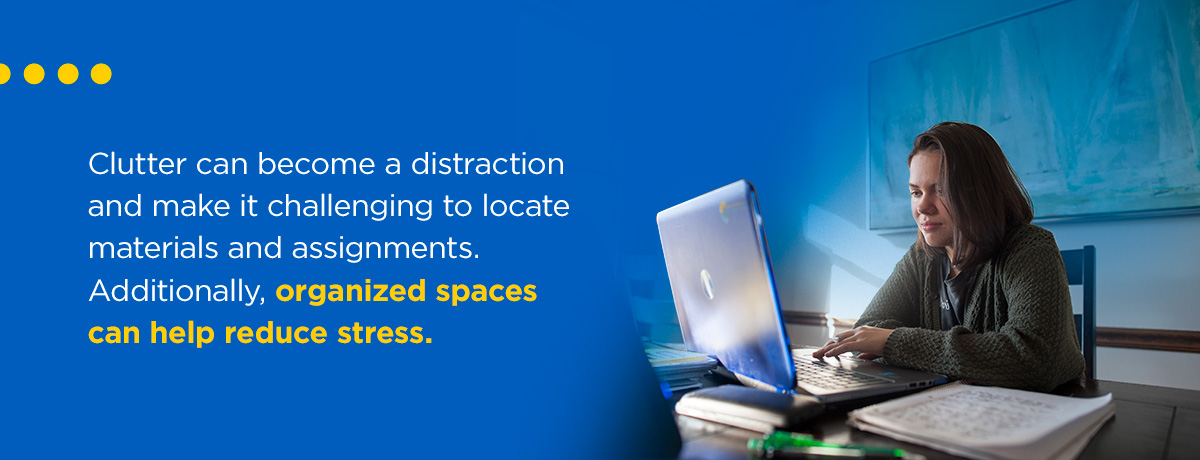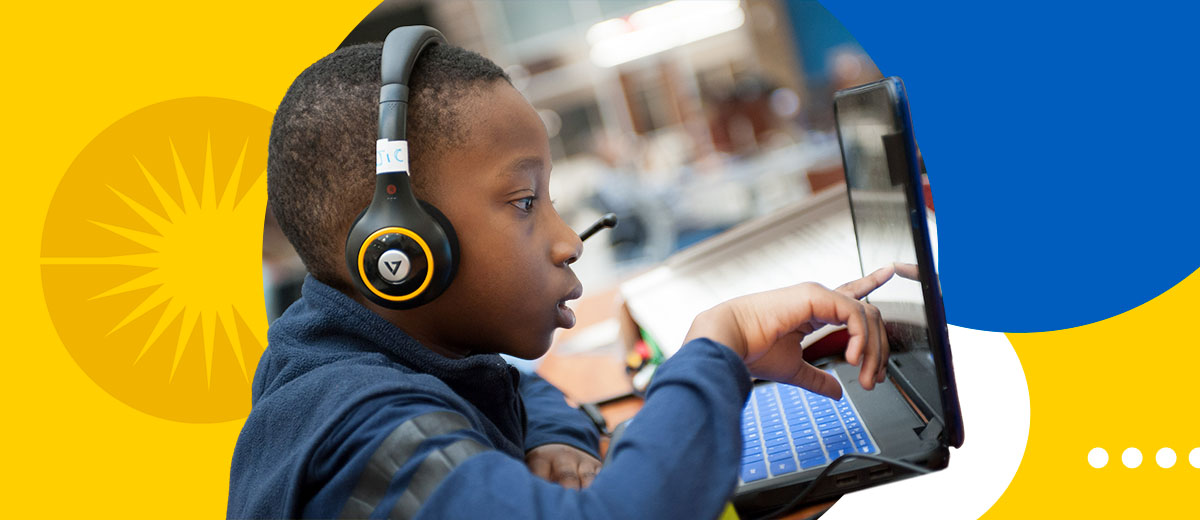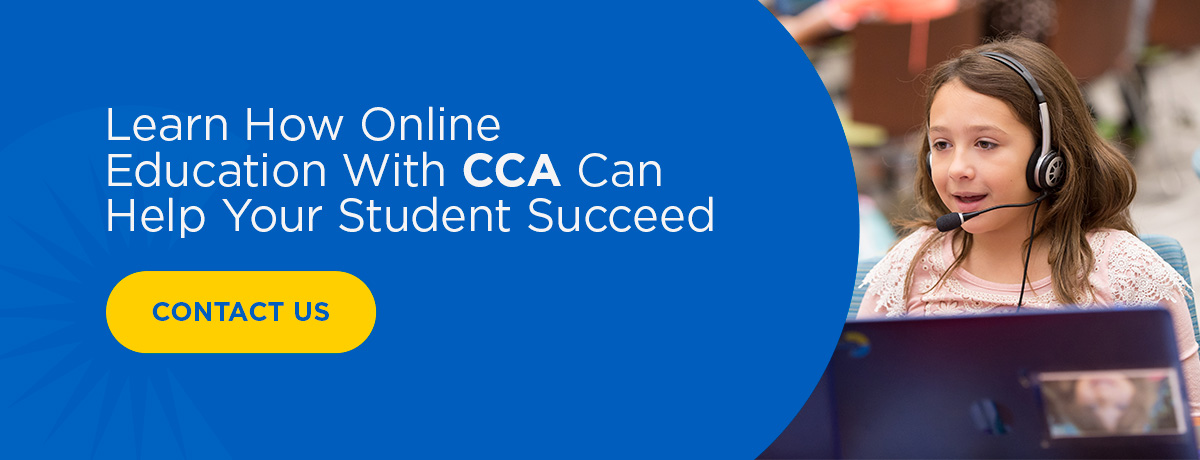Managing distractions as an online student can be a challenge. When a student’s home doubles as their classroom, it can be easy to neglect coursework for other activities, such as playing games, speaking with family members, eating, or sleeping.
Identifying your child’s distractions and helping them create a quiet space for productivity can help keep them on task and motivated. Work with your child to find solutions that work for everyone in your family and integrate a routine into their busy day.
Most Common Distractions for Online Students
Learning at home allows students and families to develop a routine that works for their schedules. However, having a classroom in the bedroom comes with its challenges. Many online students must find ways to manage distractions that are not present in brick-and-mortar institutions.
Technology
Mobile phones are perhaps one of the largest distractions for students in any setting. With social media notifications popping on the screen at all hours of the day, it can be challenging for students to stay focused.
Gaming consoles and video games can also distract students or enable procrastination. A child may decide to take a break to play a game and end up playing for hours on end without touching their coursework. Additionally, video apps and streaming platforms can make it hard for students to stay on task, especially if they use devices to study.
Family
Family members and pets can create background noise that is hard to ignore. If students feel they’re missing out on a fun event or conversation, they may neglect their work to be included. Pets may hop onto students’ laps or desks while they try to study, leading them to break focus to play with them.
Furthermore, students with siblings learning from home may distract each other. If two or more siblings share a workspace, they may face conflict when deciding what tasks to perform. While one sibling is listening to a lecture, another may be trying to read a text but cannot focus on the words they’re seeing because they hear another voice.
Background Noises
Indoor and outdoor noises can present audible distractions for many students. Children playing across the street, parents cooking meals, and siblings talking with friends can make focusing challenging. Additionally, small noises can become more present in complete silence, leading students to notice objects they typically wouldn’t, such as a clock ticking or a pencil scratching on paper.
How to Avoid Distractions in School
The first step in avoiding distractions at school is to identify weaknesses and form a plan. Sit down with your student and discover the most distracting elements of their day or study time.
You can take a few steps to resolve technology distractions. One effective step is to create a computer account for school work and block websites you don’t want your child accessing. Streaming services and video sites like YouTube are great places to start. Encourage your child to turn off notifications so they will not get distracted by their phone while studying. Consider moving your child’s workspace to a location without video games or place the consoles in a family area, such as the living room or basement.
To combat family members and conflicting schedules, create a routine that works for everyone. Consider setting up different workstations for each child so one does not distract the others. You should also develop a system that lets everyone in the house know when to stay away. For example, if the office door is closed, you know to let your child work in peace. Encourage all family members to stay out of the room until your student is done for the day.
Tackling background noise may take some trial and error. First, you should not encourage your student to work in complete silence because small noises can become irritating. Perhaps your child could listen to an instrumental playlist while they work. This way, they can enjoy the noise without getting distracted by the lyrics.
You could also invest in noise-canceling headphones so your child can watch lectures and review class materials without facing interruptions. You should also try to eliminate other distractions where possible. For instance, encourage your family to watch television in their bedrooms instead of the living room if the sound carries to your child’s workspace.
Eliminate Distractions While Studying
Work with your child to find a quiet location to study. Although they might like the vast kitchen table, an uncontrolled environment can present many unknown distractions. Family members coming in and out can break concentration, and being so close to snacks can make spontaneous walks to the refrigerator much easier.
Instead, you should design a space for work. If you don’t have an office or bedroom space, you can make a study space in many other locations. A well-lit basement or hallway could be the perfect spot for your child to set up shop. You can design an alcove, build a shelf, or transform a closet to accommodate your child’s desk and storage space. Almost anywhere can be a great study space as long as your child can work comfortably without other family members or pets distracting them.
Create a To-Do List and Stick to It
Creating to-do lists and preparing for the next day can motivate your child and help them know what tasks they need to complete. As they wrap up schoolwork, they can feel satisfied with their productivity and know what’s coming next.
Work with your child to create a weekly plan for the upcoming days. Look at their assignments and determine what tasks need attention and when. Ensure your child notes all due dates and prepares for big project deadlines. Leave some time for studying and always add fun to-dos so that your child has something to look forward to each day.
Stay Organized

Getting organized is one of the best ways to get productive and efficient. Clutter can become a distraction and make it challenging to locate materials and assignments. Additionally, organized spaces can help reduce stress.
Start organizing your child’s workspace by taking inventory of their materials. Avoid buying new materials until you account for all your home’s pens, pencils, highlighters, and other supplies. Help your child create a color-coded system for coursework. For example, buy a blue notebook and folder for math, green for science, and so on. This way, your child will know where to put and find any related materials.
Find Tools to Help Reduce Distractions
If your student is still struggling to remain on task, there are plenty of virtual resources at your disposal. You can download apps and other resources to help your student make the most of their time and be productive.
Study applications and tools include:
- Timers: Students can use timers to dedicate specific time to tasks and incorporate small breaks.
- Virtual calendars: Your child can access their due dates and schedules from anywhere with an online calendar.
- Virtual flashcards: Sites like Quizlet enable students to create flashcards and quiz themselves.
- Site blockers: Downloading the Freedom App allows you to block sites or the internet entirely while your student is studying.
- Fun apps: Forest is a mobile or desktop application that encourages students to put their phones down. Students virtually plant a tree and set a timer for 25 minutes. If your student switches to another app, the tree will die. If they successfully stay off their phone, the tree will grow. Your child can produce an entire forest and fund real tree planting as they use the app.
Learn How Online Education With CCA Can Help Your Student Succeed
CCA is dedicated to delivering an online education that engages our learners and their families. We want to help shape today’s students into tomorrow’s leaders, and we know we can’t do this with a one-size-fits-all approach. Your student deserves a customized education that works with their schedules and peak productivity hours. CCA offers individualized academic plans and unique courses that lead our students to success while still being flexible.
Encourage your student to pursue an education that aligns with their interest and helps them stay productive. Contact us for more information about our school and how we can help your student succeed.




